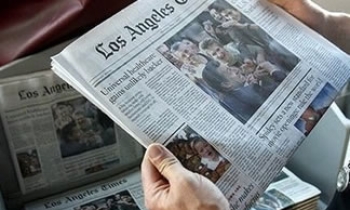NEW YORK (AdAge.com) -- It took a little while, but most magazine and newspaper publishers eventually accepted the need to establish web versions of their cherished print properties; it was pixelate or risk perishing. But now those same publishers are demonstrating a growing belief that while those companion sites are necessary, they are not sufficient.
Hearst Corp. acknowledged as much last week when it revealed a deal to buy UGO Networks, a suite of men's lifestyle sites about games, movies, TV, movies, music, sports, women and comic books -- but little connection with established Hearst magazine brands such as Esquire or Seventeen. Condé Nast Publications has been busily building sites such as Flip.com, Lipstick.com and others with zero old-media roots. And who can forget Time Inc.'s online-only Office Pirates, both born and axed in 2006? It may have survived only six months, but its parent has promised to try again.
Part of the drive stems from the failures of many print brands to make much of themselves on the web. Hearst's Esquire.com drew 247,000 unique visitors in June, according to ComScore Media Metrix; UGO sites got 11.2 million.
"A lot of companies are aware of the fact that big media brands have not successfully migrated online, or that there's certainly a lack of them," said Jonathan Simpson-Bint, president of Future US, publisher of magazines such as Guitar World, Pregnancy and PC Gamer. "So the feeling is we need these new brands."
New players dominate
Even an established online player such as Time Warner's AOL has found more success with gossip site TMZ than it ever did depending on Time Inc. brands such as People.com. TMZ drew more than 9.3 million unique visitors in June, up 99% from last June, ComScore said. People.com, now in Time Inc.'s control, got fewer than 6.1 million, up 29%.
Future US has a lot invested in magazine companions such as GuitarWorld.com, but it also just launched a brand at Gloob.TV, where editors present videos picked from the ocean of available clips. And that curated experience was supposed to be the main draw, but already visitors are making good use of another element: the ability to embed their own videos in the comment threads.
New digital brands can draw from those sorts of interests and influences of crowds -- in a way that established names can't. "A lot of the big successes online are successful at something that wasn't their original goal," Mr. Simpson-Bint said. "MySpace was built to be basically a network for bands. They didn't really think that 20 million kids were going to go get their own home pages on there. If you put something out there and it's exciting and malleable and connects with people, the audience will potentially take it in a different direction. You have to create the room for these things to take place. That's possibly why established media brands have struggled online -- because there's automatically baggage."
Not giving up
It's not that anyone, including Future US, is giving up on digital companions for print properties. They remain the centerpieces of most online businesses run by traditional print operators, who view other acquisitions or launches as complementary.
"You take Seventeen.com and some of our teen magazines ... it translates pretty well," said Ken Bronfin, president of Hearst Interactive Media. "UGO reaches an 18-to-34-year-old male demographic, which is often difficult to reach with traditional media properties."
Established print brands have an opportunity to capitalize on their currency among advertisers and readers, said Eric Blankfein, senior VP-channel insights director at Horizon Media. "The approach to promoting the web versions of competing magazines is what's key, not the fact that they haven't been created from the ether," Mr. Blankfein said.
But online brands' central focus on digital and ability to offer interactive experiences, among other things, overpower the strength of magazines' print brands and content, said Rishad Tobaccowala, president of the Denuo Group. And where eyeballs flock, advertisers tend to follow.
Buying blog cache
There are, of course, different ways to deploy a brand online. Complex magazine, where Complex.com is an important part of the brand footprint, has just formed partnerships with the independent blogs Nice Kicks, Nah Right, Bastardly and SlamXHype. Each deploys classic internet irreverence and subject expertise to attract and maintain its audience. Complex could have tried building similar blogs on its own site, but it didn't see as much upside.
"When you have an opportunity to get in bed with and partner with people who are pure and organic as possible, especially in the trend marketplace, it'd be insane to reinvent the wheel," said Rich Antoniello, publisher of Complex. "Also you can't just decide, 'We're going to be pure and organic.'"
At Condé Nast and its CondéNet division, destination sites such as Epicurious.com are meant to be big ad plays while companion sites such as VanityFair.com are meant to enhance print readers' relationships with each title.
'Companions'
"You could try to build a really big site based on a brand," said Sarah Chubb, president of CondéNet. "We have just chosen to be very focused on having the sites be companions to the magazine. That means echoing the brand, supporting the brand, giving the person who's really into that magazine more to do online. Which is very different from trying to make a big magazine site itself."
The new brands do lend themselves to faster growth, Ms. Chubb added. "A brand like Epicurious, because it was a new brand, had elasticity to it that meant, from day one, that we could make it what we wanted, which was the No. 1 destination for food online. If you're working with a pre-existing brand, a pre-existing corpus, it's a different thing."









